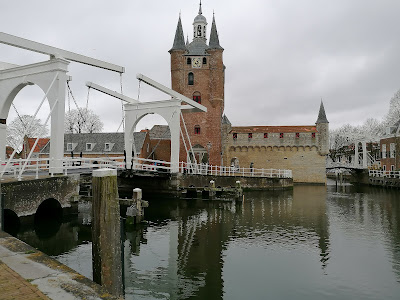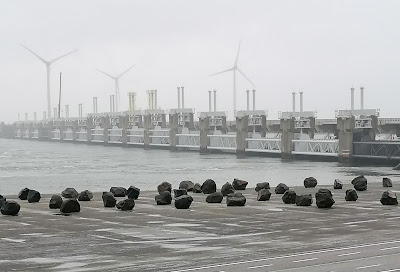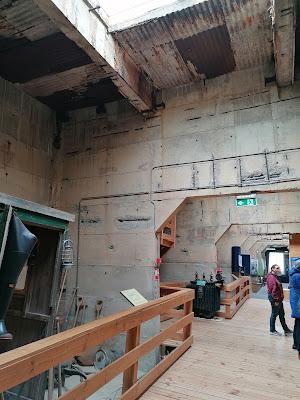Day 8 - Wednesday 3 April 2024
The morning included excursion started with a walk through the attractive small city of Zierikzee.
Access to the old town and harbour was via pull-up bridges and a gatehouse.
Four coaches had set off from the boat, but to avoid crowding only two visited the same site at the same time.
We drove first to the Delta Works. Local fishermen objected to the enclosing of the Zuiderzee as the enclosed water would become salt-free and wouldn't support the fish they caught and oysters they farmed.
So either side of a man-made island were constructed a line of gates which would let sea tides ebb and flow, but be shut during exceptional high tides to protect land and dikes.
All week we'd been hearing about land reclaimed from the sea and how much of the Netherlands is below sea level protected by dikes.
Our last visit was to Watersnood (Flood) Museum. This is at the site of a dike break on 1 February 1953. A storm surge and gale caused wide spread flooding and drowned 2,500 people in Netherlands, Belgium, England, and Scotland. Netherlands suffered the most because it had so much land under sea level.
Engineers repaired breached dikes but all attempts at closing the dike at Ouwerkerk were washed away by the force of the currents. On the night of 6/7 November 1953 they carefully manoeuvred a line of four huge floating concrete caissons into the breach, filling then with boulders and sand to sink them. Even so, the currents moved one out of line but the engineers were able to fill gaps and repair the dike.
The caissons - codenamed Phoenix - had been constructed to make the artificial 'Mulberry' harbours and breakwaters of the Normandy coast after D-Day in 1944 but these were surplus to requirements then and were towed by tug to Netherlands in 1953. They stick up above the earthen dike and now house the museum.
The caissons are gigantic, 62.5x19x19 metres (205x62.3x62.3 feet), and the museum is housed in the upper part, above the rock and sand filling.
And back to the boat for lunch. The boat cast off heading for Rotterdam. There was on 'Open Wheelhouse' session and then 'Teatime'.
Plates of dainty sandwiches and cakes were on lounge tables, with jam and cream for scones. We were supposed to enjoy a selection of specialist loose-leaf black and green teas with them, but actuality was the same wooden box of tea-bags we had a breakfast was brought around by waitrons. Dunking a tea bag into a cup of hot water doesn't make tea as any fule kno.
And where were the scones? The restaurant manger said they'd run out, but perhaps because I took him to task the previous day for running out of the diet cokes our lunch companions wanted, he rustled up one each for those at our table. They were stale, more like small biscuits.
We had the misfortune to sit through the Programme Director's disembarkation talk in which, with the aid of a projector, he droned on into minute detail about every aspect even explaining what each column of the Departure Information sheet meant, perhaps because a column headed 'time to place your luggage outside your stateroom door' would cause of confusion.
We arrived in Rotterdam during dinner. A pre-dinner glass of Champagne and a bottle of dry red restored equilibrium.
We left Rotterdam for Amsterdam at 22:00. Tomorrow would be the last full day of our cruise, and highlighted by the included excursion to Keukenhof Gardens.
To go to Day 9 click here











No comments:
Post a Comment